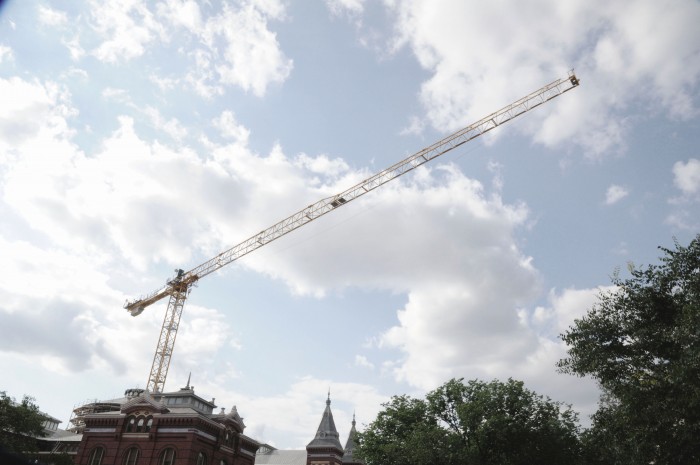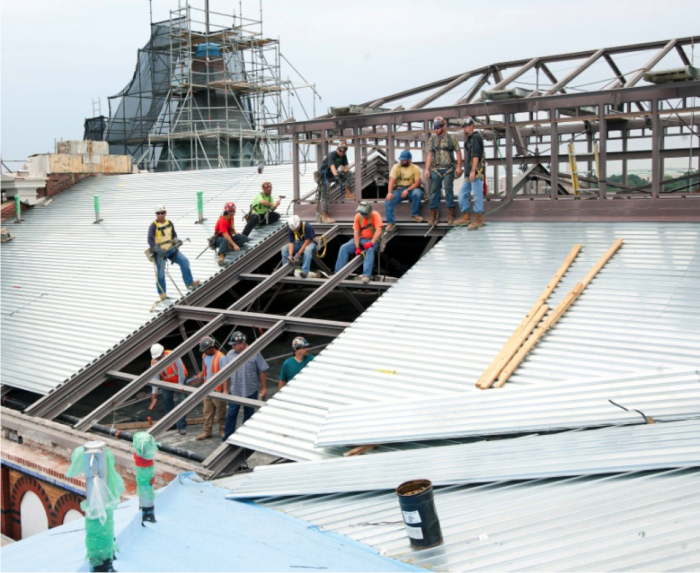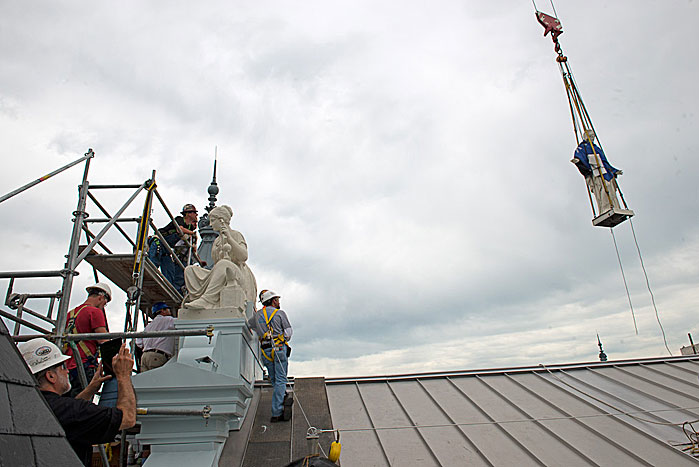Can an old building learn new tricks? The Smithsonian Innovation Space at the Arts and Industries Building
Where a new way of thinking results in a change: Pherabe Kolb, Project Director of the Smithsonian Innovation Space at the Arts and Industries Building, explains how a venerable architectural treasure is being restored as a place to celebrate some very 21st-century ideas.
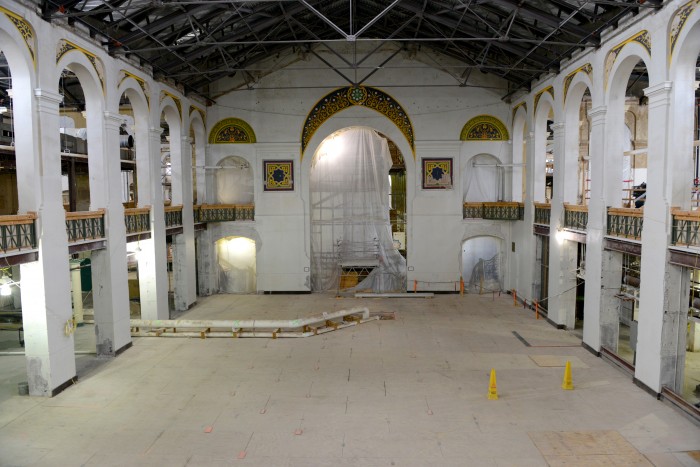
The North Hall of the Arts & Industries Building, October 2013. The building is expected to reopen in late 2014. (Photo by Brendan McCabe, Smithsonian) Magazine.
Can an old building learn new tricks?
That is one of the questions that pops into my mind every time I walk inside the Smithsonian’s Arts and Industries Building. The A&I, a symbol of 19th-century ingenuity and optimism, is under construction in anticipation of its new role as a place for celebrating some very 21st-century ideas, namely innovation and all its causes and effects. It’s expected to open in late 2014.
This newly reimagined venue—to be named the Smithsonian Innovation Space at the Arts and Industries Building—will be a “pop-up museum” where we will host educational activities, events and changing virtual displays. The building’s iconic location on the National Mall will provide the ideal spot to convene today’s thinkers, creators and inventors from across disciplines to engage in conversations about innovation that will illuminate, inspire and inform our audiences.
The heart of the building’s educational and interactive activities will be the “Innovation Pavilion” made possible in part by the Smithsonian’s collaboration with the U.S. Patent and Trademark Office. Activities in the Innovation Pavilion will include a focus on how innovation results in new technologies and inventions, featuring the stories and perspectives of inventors of all kinds, along with what steps it takes to get from the question to the answer, the problem to the solution and the inspiration to the outcome. We are hopeful that this space can support a range of public programming and events, including regular demonstrations of new inventions and technologies from across industries, inspiring the next generation of inventors, entrepreneurs and creative thinkers.
But this new purpose would not be possible without some major TLC for this grand old space, made possible by the hundreds of people who have been laboring daily over the last few years to bring this building back to life.
The A&I has been closed since 2004, and since 2009, has been undergoing some long overdue repair and restoration to revitalize the shell of the building and make it possible to welcome people safely into the space again.
Those of you who have visited this building in its previous lives as a special exhibition space and museum will most certainly remember its distinctive and playful exterior, marked by colorful patterns of brick punctuated with a series of striking towers and pavilions. Or maybe you recall coming through one of the grand entrances and having your eyes drawn immediately to the soaring ceilings and archways that grace the interior halls.
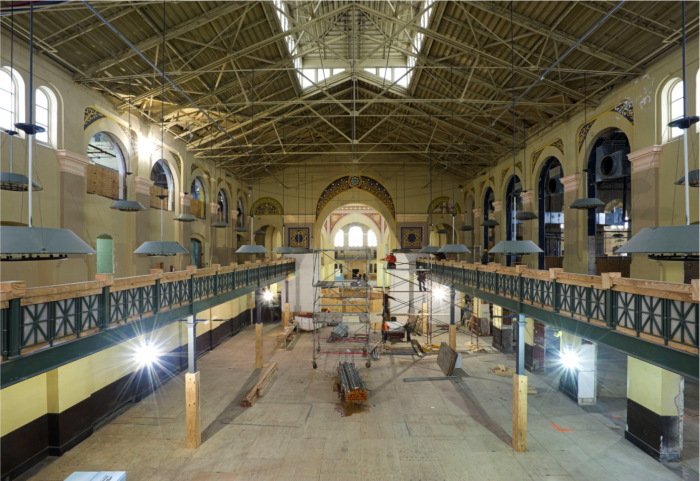
The renovations to the Arts & Industries Building are helping restore the space so visitors can see the “bare bones” of the historic structure. (Photo by Chris Lethbridge)
But even if you have never visited, you will be pleased to know all of the work we’ve been doing inside and out is designed to respect and repair the unique elements that have made A&I such an important part of the Smithsonian family of buildings over the last 132 years. This is not a full renovation, only an interim one, so some of the more detailed finishing work and features will be left incomplete. As a result, visitors to the space will be able to see and appreciate the “bones” of the building, giving the space a pop-up feel and loft-style look.
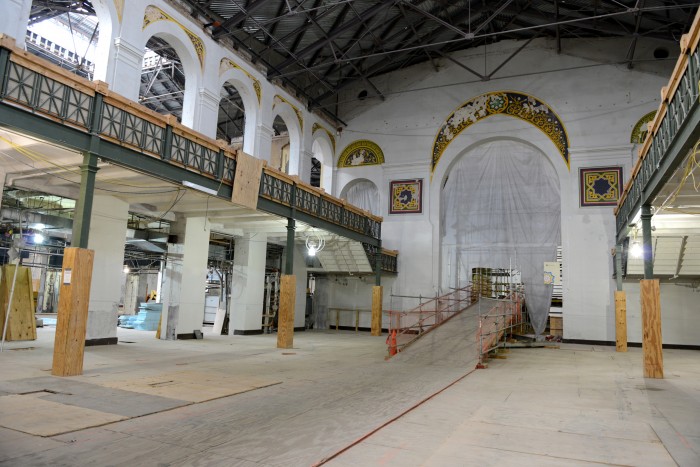
This space, undergoing renovations in the Arts and Industries Building, could be used for future pop-up exhibitions or demonstrations. (Photo by Brendan McCabe, Smithsonian Magazine)
First on our list of things to do was to replace the roof. The roof, with its original wrought-iron structure and modern plywood and sheet metal covering, was failing in places and spouting an unending series of leaks in others. So we replaced it with a new stainless steel roof designed to weather even the most snowy of D.C. winters. Reaching the roof from the outside required we mount an enormous construction crane in the very center of the building, which towered over the Washington skyline for years. It also created a very interesting decorative element in the building’s interior, giving a whole new meaning to the phrase “industrial look.”
Until very recently, every hall was filled with floor-to-ceiling metal scaffolding topped with a plywood “dance floor” that allowed workers access to the underside of the roof. While in place, this interconnected steel grid gave the building interior the feel of a giant Erector set—and for those willing to brave the 50-plus-foot heights and a climb up some perilous stairs, a rare glimpse of the building from a bird’s-eye view.
As the scaffolding began to come down, it revealed sightlines not seen inside this space in more than 100 years. Sunlight streamed in; unobstructed North-South and East-West cross views appeared. Why the dramatic change? Over the years, the open, exposition-hall-style design intended by architect Adolf Cluss was carved up into dozens of offices, rooms and galleries each with its own special purpose. In fact, by the time it closed in 2004, nearly two-thirds of this building was dedicated to behind-the-scenes support for important administrative, education and outreach functions of the Smithsonian Institution
Another major project was replacing the building’s 800 windows. Each new window was designed to mimic the historic look of the frosted glass that originally adorned these portals. The glass contains a unique patterned layer so visitors inside can enjoy the views out on to the National Mall, but from the outside it appears frosted and screens views into the exhibition galleries during the day. Unlike their predecessors, the new windows are also models of current-day efficiency, safety and security.
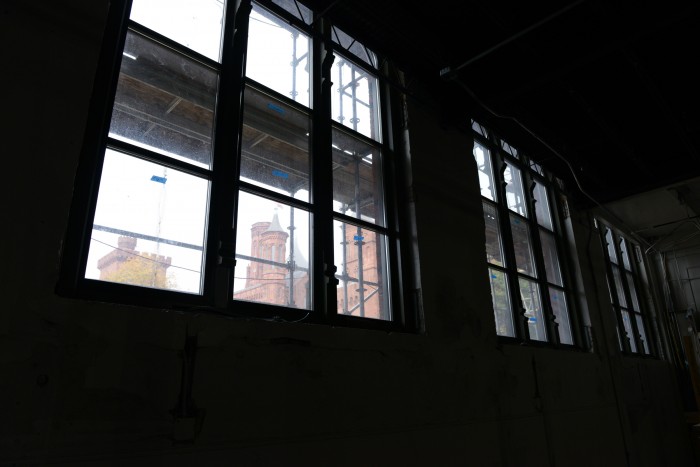
The new windows allow visitors a clear view out of the building for the first time, but keep intact the appearance of milky glass for those on the outside looking in. (Photo by Brendan McCabe, Smithsonian Magazine)
We have also had the chance to give facelifts to some of the building’s more decorative features. The lavender- and gold-stained glass in the large arched windows over the four entrances has been entirely restored and features the compass point —N/S/W/E—toward which the window is facing (an especially helpful marker when leading aconstruction tour and trying to act like you are not lost and can easily find the exit through a maze of scaffolding and scrims).
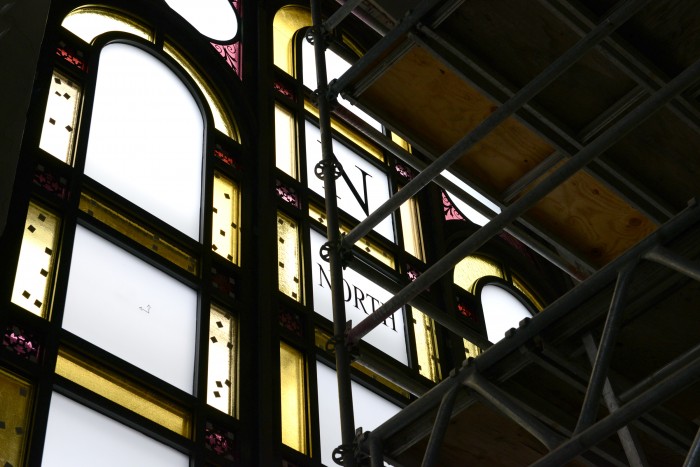
The compass markings Adolf Cluss designed to appear on the building’s original stained glass windows were restored in this renovation. (Photo by Brendan McCabe, Smithsonian Magazine)
Another aesthetic—and symbolic—improvement is the removal, repair and reinstallation of the sculpture that sits atop the main entrance. The three female figures in the artwork, known as Columbia Protecting Science and Industry, capture the spirit of what A&I has always been and what we hope it can be again: a place to learn, experience and dream about innovations across a host of disciplines.
So can this old building learn some new tricks? One way or another, we’re about to find out.
“Reinventing the Nation’s First Museum” produced by:
Science Media Group, Smithsonian Astrophysical Observatory.
Executive Producer: Alex Griswold | Motion Graphics: Rachel D’Erminio
Editor: Teresa Hartmann | On-Line Editing: Maria Kobrina
Additional Videography: Lauren Farrar
All images courtesy of Smithsonian Institution Archives.
Music: Pond5.com
_____________________________________
UPDATE Jan. 28, 2014
Smithsonian Secretary Wayne Clough announced today that the Arts and Industries Building on the National Mall will not reopen later this year as originally planned. This decision was made for financial reasons.
Plans for the 133-year -old building called for creating an interim program called Smithsonian Innovation Space. After a year of program planning and financial review, the Smithsonian concluded the cost of rehabilitating the building for public use and operating it exceeded available funding sources at this time. The building’s exterior has been structurally stabilized with $55 million from federal funds.
Legislation pending in Congress names the building as the preferred site for the Smithsonian American Latino Museum. The Smithsonian has agreed to explore only interim uses for the building while Congress debates the legislation.
The Smithsonian will continue to explore options to reopen the building, but it will remain closed to the public until further notice.
Posted: 15 November 2013
-
Categories:
Art and Design , Collaboration , Feature Stories , History and Culture , News & Announcements , Science and Nature
